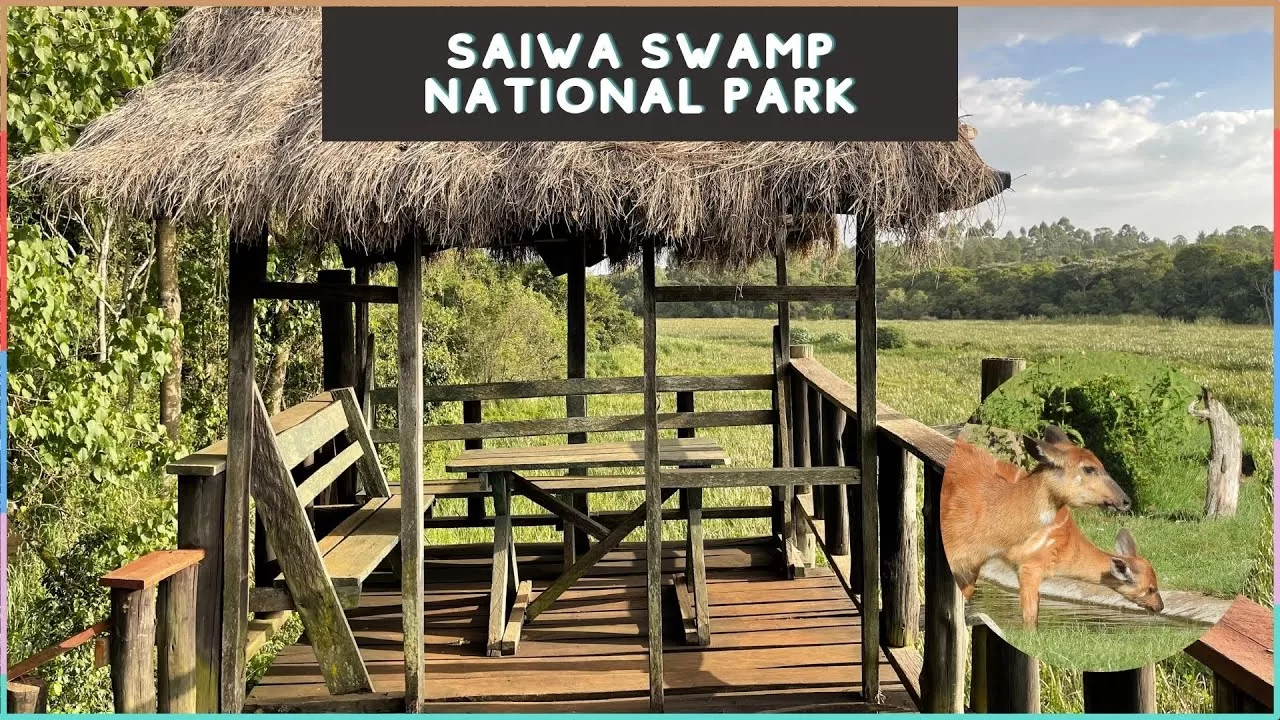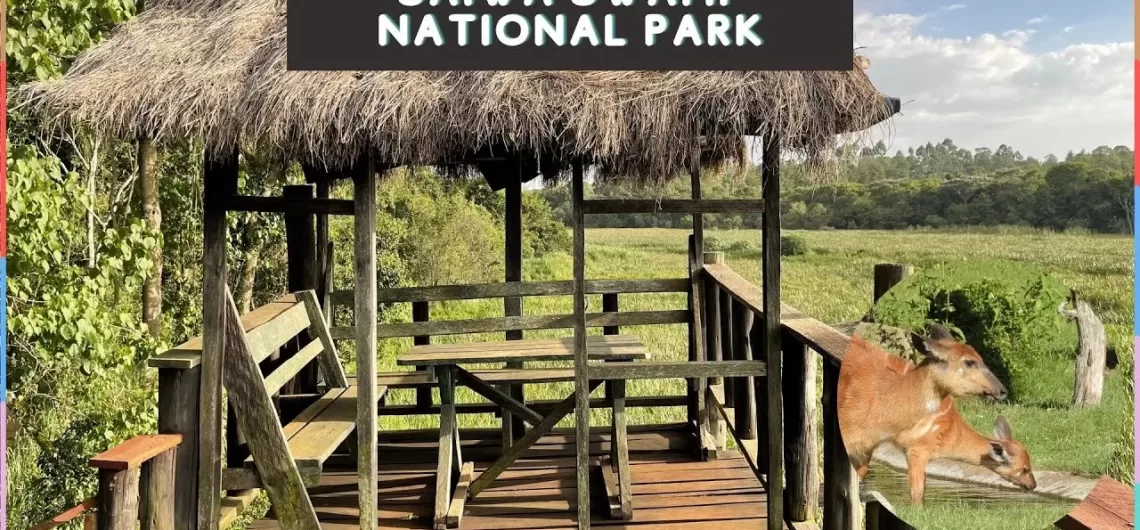Saiwa Swamp National Park
Sitatunga’s aquatic domain
Rippling quiet waters meander beneath the boardwalk amidst rustling reeds and bulrushes, as a glimpse of the sleek Sitatunga antelope catches you by surprise. Sounds of nature fill the air as the rare De Brazza’s monkey rattles a branch and birds swirl in flight. Saiwa Swamp is nature’s private reserve. An ornithologist’s delight.

Swamp facts
The Kenyan government created the smallest National Park in Kenya to protect the habitat of the rare and endangered semi-aquatic sitatunga antelopes and Brazza’s monkeys. Saiwa Swamp abounds with birds and wildlife plus diverse and plentiful flowers and trees.
Dominated by bulrushes and other aquatic plants, winds its way through the wetland , and by run-off from the surrounding riverine forest.
Attractions
Wildlife
Saiwa Swamp National Park protects its resident population of Sitatunga antelope (tragelaphus spekei), which are believed to number as many as 100 animals.
Belonging to the larger antelope family, the Sitatunga is uniquely adapted for its favoured wetland habitat. The only other known Kenyan populations are in the papyrus swamps of Lake Victoria and the Kingwal Swamp near Kapsabet.
Crepuscular and extremely shy, these antelope hides in papyrus and almost submerge themselves when alarmed. Sitatunga’s have brown coats, transverse white stripes on their backs and elongaged splayed hooves which enable them to walk on the surface of the swamp. The males have twisted horns.
Look for the nocturnal pottos(relatives of the bushbaby), Spotted-necked otters, giant Iorest squirrels, the black and white colobus monkey, bushback and bush duiker as well as small groups of De Brazza’s monkeys.
Birdwatching
Birdlife is abundant. Waterbirds include the lesser jacana, grey heron and African black duck among others.
The forests shelter the Narina trogons, one of Kenya’s most spectacular forest birds. Watch for the collared and orange-tufted sunbirds, sipping nectar from the flowers of the forest edge. The yellow bishop often whirrs above the reeds, its blazing yellow back on display. Hartlaub’s marsh widowbird also frequents the rushes. Noisy Ross’s turaco’s are difficult to miss while the paradise flycatcher and the lovely black-headed qonolek are easy to see along the trails.
Ludher’s bush—shrike is much shier while the square-tailed drongo and the double-toothed barbet perch in the lower branches of forest trees. Cinnamon-chested bee-eaters abound, as do crowned cranes, especially when the surrounding farms are ploughed or harvested.
Plants
Within this tropical wetlands and mosaic of riverine forest, sedges and acacia woodlands, with fringing dense rushes and grass beds, are some of Kenya’s loveliest terrestrial orchids. The bronze and purple eulophia horsfallii, the fleshy pink satyrium crassicaule and the crimson satyrium sacculatum orchids abound, including the comet orchid, with greeny—white , flowers fading to peach. Epiphtic ferns flourish.
The wetter riverine forest is marked by spreading afzelia trees and gigantic strangler figs(Ficus). Syzygium trees, with their dark-purple fruits, are not uncommon along the edge of the swamp.
Insects
The swamp is exceptionally rich in dragonflies and damselflies. Butterflies include swallowtails and charaxes. The African mocker swallowtail, papilio dardanus, is very common after the rains. Across the forest floor, ants swarm.
Reptiles and Amphibians
Frogs and toads abound, with many different kinds of tree frogs trilling and piping after ‘ rainstorms. Bell’s hinged tortoise, a forest-dwelling species, is found in the park and the blue-headed tree agama lizard is sure to cross your path. Snakes include the forest cobra and African rock python. As you follow the trails, watch for a side-striped chameleon. They are common, but easy to overlook due to their excellent camouflage.
Where to stay
Camping areas:
The park has a serviced campsite at the main gate. Facilities include hot showers, flush toilets, f barbeques, electricity plus various shades and shelters.
Other campsites and accommodation are available at the nearby Sirikwa Tented Camp located on the r main Kapenguria road, 6km after the Saiwa Swamp junction, it offers a campground with tents for hire and a guest house too.
What to take with you
Plenty of drinking water, picnic or camping items if you intend to stay overnight, plus binoculars, camera, hat, sunscreen, sunglasses, insect repellent, anti-malaria prophylactics, walking shoes and field guides.
Fact file
Area:2.9 sq km
Altitude: 1,820-1,880 meters above sea level
Location: Trans Nzoia District, Rift Valley Province.
Gazetted:1974
Climate: Typical of African wetland habitats, the wet and dry climate ranges from warm to cool and humid. Rainfall peaks around April, August and November to deliver an annual average of 1,250mm.
Vegetation: Swamp, riverine forest, bulrushes reeds
Mammals: includes Sitatunga, monkey, otter, genet cat, serval cat, mongoose, bushbuck and ratel.
Birds: 372 species including such rarities as Ross, turaco and blue-headed coucal.
Roads: The park has no roads, only walking trails.
Open daily: Dawn to dusk-6.00am to 6.00pm. No entry is permitted after 6.l5p.m All vehicles must park at the gate and entry is by foot only.
Current entry charges: Obtainable via KWS HQ ( Nairobi) +254 (20) 600800, 602345.
Email: reservations@kws.go.ke
Safari card required? At present the Park do not operate the Safaricard. Entry is by cash only (Kshs, US$)
Contacts: The Senior Warden:
P.O.B0x 4506, Kipsaina Tel: +254 (020) 05455022
Email: saiwapark@kws.go.ke
How to get there
By road
Saiwa swamp National Park is 22km
